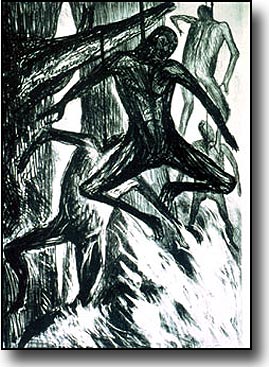San Diego Museum of Art,
Mar 09, 2002 - May 19, 2002
San Diego, Ca, USA
Exhibition Press Release
by LatinArt.com
Beginning in 1927 Orozco spent seven years in the United States. These years coincided with unprecedented cultural exchange between Mexico and the United States. During this time, in addition to his important murals at Pomona College, Claremont, California; the New School for Social Research, New York; and Dartmouth College, Hanover, New Hampshire, Orozco created a substantial body of work in other media. Viewed as a whole, his work from this period sheds light on the artist’s complex creative and political development and provides an illuminating case study on the influence of Mexican visual artists in the United States.
Orozco’s contemporaries Diego Rivera and David Alfaro Siqueiros also visited the United States in these years, but their stays were brief. Traveling north from Mexico to seek new patrons for their mural commissions, these three artists all confronted an unfamiliar culture and a modernity that at once attracted and repelled them. Orozco’s works, including his mural commissions in the United States, were deeply affected by these experiences. His murals brought him the international recognition that he desired, and when he returned to Mexico in 1934, he did so with a strong reputation and new mural commissions in his homeland.
The works in the exhibition show the significant impact living in the United States had on Orozco’s art, resulting, first and foremost, in the production of a new and extensive body of work that covered a broader range of subjects than the artist had treated before. During this period, he continued to focus on the intellectual and social issues that had long been his central concern, but he no longer treated them exclusively in terms of Mexican subject matter. Thus visitors will see alongside his paintings and drawings of the people and landscape of his native country - e.g., Colinas Mexicanas (1930) or Desfile Zapatista (1931) - representations of the modern American metropolis: its skyscrapers and bridges, its workers, and those who lost their jobs during the Great Depression.
Also on view, images such as Mannikins (1931), Aquella noche (1930), and Los muertos (1931) demonstrate the artist’s awareness of and engagement with contemporary art in Europe and the United States. In addition, the exhibition includes a number of preparatory drawings for the three murals he executed in the United States, providing remarkable insight into Orozco’s working method and his development of the murals from initial conception to the final product. Finally, another important aspect of Orozco’s work included in the exhibition is the striking lithographs he created in the late 1920s and early 1930s, his first works in this medium.
A fully illustrated scholarly catalogue, available in both English and Spanish editions, accompanies the exhibition. It features essays by a multinational group of art historians including Dawn Ades, Alicia Azuela, Jacquelynn Baas, Karen Cordero, Rita Eder, Renato González Mello, Diane Miliotes, James Oles, Francisco Reyes Palma, and Victor Sorell.
This text was reproduced from the exhibition Press Release with permission from the San Diego Museum of Art, USA.
|









